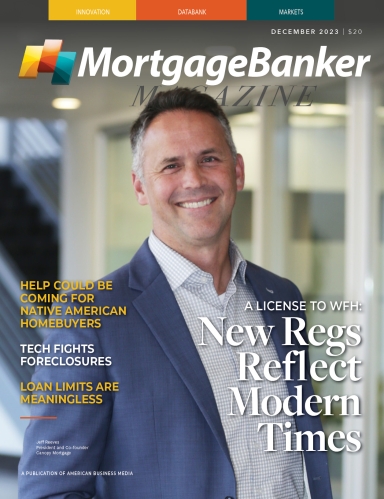Yet, borrowers and loan officers do not understand the home buying process on the same terms. Borrowers see applying for a mortgage as a single process: buying a home. Potter holds the mortgage industry responsible for dividing that process into four parts: real estate, title, mortgage, and insurance. “We’ve still not truly embraced that it’s one thing to consumers,” he laments. “We keep trying to make it four things, but feel like one to them.”
McCracken echoes Potter, saying the industry used to protect the consumer “from how the sausage is made.” But, that hasn’t been the case since 2014, when Rocket Mortgage (then Quicken Loans) put the mortgage application directly into consumers’ hands. Since then, lenders buying off-the-shelf technologies or those developing in-house tech stacks are chasing what McCracken calls “the digital veneer” – a melding of technologies that creates a seemingly seamless, web-based experience that is identical for loan officers and consumers.
Next-Gen Lending
For almost a decade, Reeves says the industry’s prevailing strategy has been, “if you give this borrower a really great experience and allow them to interact with you upfront in ways that are unique and that allow them to do some of the work, it will drive down the cost. Curiously, it hasn’t. It’s only gotten worse.” Most lenders have not succeeded in adopting technologies that effectively integrate the consumer into the loan process. “Often, those systems are kind-of integrated, and when you’re kind-of integrated, you’re not integrated,” he says.
Companies run into trouble when they cobble together incompatible technologies. Anyone who has opened a Microsoft Word attachment on a computer only equipped with Pages has experienced the frustration of fixing fonts that failed to transfer and adjusting squirrely formatting. Be it an archaic loan operating system (LOS) or a just-built digital closing portal, disparate systems driven by different code bases and databases just don’t communicate well.
Managing the cost to produce has always guided Reeve’s operational approach. His first foray into mortgages was co-founding Box Home Loans in 1998, a consumer-direct business built around a single loan product called the Countrywide Fast and Easy. The loan required no income or asset verification, and the company grew wildly in Utah, from $8 million in monthly originations at the end of 2008 to $100 million of monthly originations by June 2009.
However, the passage of the Dodd-Frank Act brought a swift end to that hayride for Reeves and other lenders who were bouncing along on easy loans. “I turned to my partner,” Reeves remembers, “and said, ‘if we don’t automate more of what we do, we’re never gonna survive on these margins because the whole model was built on low margin, a targeted customer, easy loans.’ And so, we just began building stuff that didn’t exist at the time.” That “stuff” became Reeves’s golden ticket – called Nano, an in-house tech stack that functions as the LOS, pricing engine, POS, and compliance engine, all driven by one code base and one database.
To lenders, Nano represents the fast lane to the future of remote origination by facilitating that most delicate of relationships between loan officers and borrowers: trust. Nano achieves this trust by erasing little inefficiencies from the process, like ensuring the fee for a transfer tax is the same when customers see it on the website as when loan officers see it in the LOS. But, perhaps most importantly, Nano facilitates trust without loan officers and borrowers ever having to sit together in a licensed location.
When the pandemic sent all of Reeves’s employees home in March 2020, employees did not have to install a bunch of extra software on their personal computers because Canopy’s whole ecosystem is web-based. “If you don’t have a unified system driving all of that, and you have to have a bunch of people manipulate, double check, and triple check your data so it’s accurate, you’re going to lose all the efficiency that you gained by giving the borrower the ability to apply online,” he says. What’s more, those inefficiencies drive up costs and increase the likelihood of losing the borrower.
Most lenders must try to cobble together four different solutions to make it all work, says Reeves. “That has become for many a house of cards. It’s hard to maintain.”








